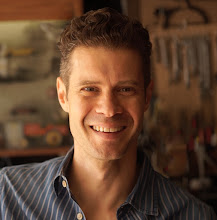Thursday, October 26, 2006
General help
Two good forums to find help:
Highend3D
http://www.highend3d.com/boards/index.php?showforum=291
CGTalk
http://forums.cgsociety.org/forumdisplay.php?f=7
Tuesday, October 10, 2006
Rolling ball is extra credit
Monday, October 09, 2006
Download the PLE
One thing to know -- you cannot save a file in Personal Learning Edition and then open it in Real I Paid For It edition.
-JP
Monday, October 02, 2006
Intro notes
Studio Arts
Introduction to Maya for Disney TV
Instructor: John Park jp@understandingmaya.com
Objective:
This class teaches the fundamentals of computer animation using Autodesk Maya 3D animation software. You’ll learn the basics of:
· Working in 3D space,
· Navigating the Maya interface,
· Creating models,
· Animating objects
· Building material shaders,
· Lighting scenes,
· Using cameras, and,
· Rendering finished work for output to print and video.
Methodology:
This is a ten-week course. Each class covers different aspects of the following topics: workspace, modeling, animation, shading, lighting, and rendering.
By covering the same topics each week, you’ll gain familiarity with the general 3D concepts very quickly. This allows the level of detail to increase quickly as well. Each class will include lectures, demonstrations and hands on work. You’ll learn a new concept and then immediately try it out.
Assignments:
The homework assignments will be exercises from the textbook Understanding 3D Animation Using Maya. I’ll also be posting updates to the blog mayaintro.blogspot.com if there are any handouts to supplement the text. You can always email me we questions at jp@understandingmaya.com.
Results:
Through continual refinement of your skills, I think you’ll come away from this class with a clear understanding of how to work in Maya. When you’ve completed the class you should be prepared for more specialized training in Maya, such as character animation, character rigging, modeling, lighting, and set design/previsualization.
Sunday, October 01, 2006
Curriculum
Workspace
❑ Introduction to the Maya Interface
❑ Cartesian Coordinates and 3D space
❑ Project Management
❑ homework – Transformation Tools p.13
Modeling
❑ Geometric primitives as building blocks
❑ homework – Barn p. 26
Animation
❑ Setting keyframes
❑ Ball bounce
❑ homework – Create Project p. 57
❑ homework – Build and Animate Ball Rolling p. 51
Week Two
Shading
❑ Shader basics
❑ homework – Shading Donuts p. 37
Lighting
❑ Point lights - intensity, color, shadow
❑ homework – Lighting Donuts p. 41
Rendering
❑ Render globals
❑ homework – Rendering Donuts p. 46
Week Three
Workspace
❑ Outliner
❑ Hotkeys
Modeling
❑ Geometry types
❑ Component mode
❑ homework – NURBS Components p. 63
Animation
❑ Pivot points
❑ homework – Pivot Points p. 73
Shading
❑ Material types
❑ homework – Material types p. 77
Lighting
❑ Spotlights
❑ homework – Spotlight p.80
Rendering
❑ Camera basics
❑ homework – Two-node Camera p.84
Week Four
Workspace
❑ Hypergraph
Modeling
❑ Curve creation and editing
❑ Revolves
❑ Construction History
❑ Extruded surfaces
❑ Lofting
❑ homework – Revolve & Extrude p.97
❑ homework – Lofting Fish p. 103
Animation
❑ Graph editor
❑ homework – Tangent Plane p. 114
Shading
❑ Texture maps
❑ Mapping coordinates
❑ homework – Barn Textures p. 120
Lighting
❑ Soft shadows
❑ Depth maps
❑ Gobos
❑ homework – Soft Shadows p. 130
❑ homework – Gobos p. 133
Week Five
Workspace
❑ Shelves
Modeling
❑ Polygon modeling techniques – box modeling
❑ Extrude face
❑ Split polygon
❑ Smooth proxy
❑ homework – Saddle p. 146
Animation
❑ Hierarchies and groups
❑ homework – Wagon Groups p. 163
❑ homework – Toon Tire p. 167
Week Six
Shading
❑ Bump maps
❑ Transparency
❑ homework – Butterfly p. 172
Lighting
❑ Area lights
❑ Raytraced soft shadows
❑ homework – Cornell Box Area Light p. 177
❑ homework – Raytraced Shadows p. 180
Rendering
❑ Depth of Field
❑ homework – Depth of Field p. 136
Week Seven
Workspace
❑ Artisan select and sculpt
❑ Docking the tool settings
❑ homework – Artisan p. 191
Animation
❑ Motion paths
❑ Driven keys
❑ homework – Motion Path Plane p. 197
❑ homework – Driven Keys p. 203
Shading
❑ Displacement maps
❑ homework – Displacement Wing p. 227
Lighting
❑ Three-point lighting
❑ homework – Three-point Lighting p. 252
Rendering
❑ OptiFX
❑ homework – Optical FX p. 184
Week Eight
Modeling
❑ Text and Bevel Plus
❑ homework – Chicken Model p. 154
Animation
❑ Skeleton basics
❑ Added attributes
❑ homework – Skeleton p. 211
Shading
❑ Toon shading
Lighting
❑ Global Illumination caustics
❑ homework – GI handout
Rendering
❑ Batch rendering animation
❑ homework – Camera Cuts p. 256
Week Nine
Workspace
❑ Show by type in view
❑ Hiding/showing, layers
❑ Snapping
Modeling
❑ Cluster deformers
❑ Lattices
❑ homework – Clusters p. 269
Animation
❑ Constraints
❑ Inverse kinematics
❑ homework – Constraints p. 276
❑ homework – IK Rigging p. 279
Shading
❑ 3d painting
❑ homework – 3D Painting p. 291
Lighting
❑ final gather in mental ray
❑ homework – Final Gather p. 294
Rendering
❑ Motion Blur
❑ homework – Motion Blur p. 299
Week Ten
❑ Touch of MEL
Modeling
❑ Advanced poly modeling tools
Animation
❑ Skinning
Shading
❑ Reflection mapping
Lighting
❑ Image based lighting basics
Rendering
❑ Rendering in layers
